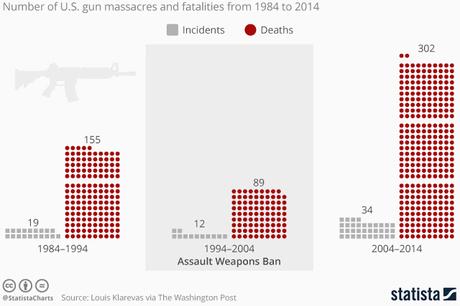 (This chart is from statista.com.)
(This chart is from statista.com.)The NRA, Republican officials, and other gun-lovers would have you believe that assault weapons (like the AR-15) are no different than other semi-automatic weapons available to U.S. citizens, and therefore should be available to anyone who wants one. They would have you believe the right to own one is protected by the Second Amendment to our Constitution.
Neither of those things is true. Our courts, including the U.S. Supreme Court, have decided that a ban on assault weapons does not violate constitutional rights. And the assault weapons are far more deadly than other semi-automatics (because of the high-velocity ammunition they use).
Following is just part of an article by trauma center radiologist Heather Sher in The Atlantic:
Routine handgun injuries leave entry and exit wounds and linear tracks through the victim’s body that are roughly the size of the bullet. If the bullet does not directly hit something crucial like the heart or the aorta, and the victim does not bleed to death before being transported to our care at the trauma center, chances are that we can save him. The bullets fired by an AR-15 are different: They travel at a higher velocity and are far more lethal than routine bullets fired from a handgun. The damage they cause is a function of the energy they impart as they pass through the body. A typical AR-15 bullet leaves the barrel traveling almost three times faster than—and imparting more than three times the energy of—a typical 9mm bullet from a handgun. An AR-15 rifle outfitted with a magazine with 50 rounds allows many more lethal bullets to be delivered quickly without reloading.
I have seen a handful of AR-15 injuries in my career. Years ago I saw one from a man shot in the back by a swat team. The injury along the path of the bullet from an AR-15 is vastly different from a low-velocity handgun injury. The bullet from an AR-15 passes through the body like a cigarette boat traveling at maximum speed through a tiny canal. The tissue next to the bullet is elastic—moving away from the bullet like waves of water displaced by the boat—and then returns and settles back. This process is called cavitation; it leaves the displaced tissue damaged or killed. The high-velocity bullet causes a swath of tissue damage that extends several inches from its path. It does not have to actually hit an artery to damage it and cause catastrophic bleeding. Exit wounds can be the size of an orange.
With an AR-15, the shooter does not have to be particularly accurate. The victim does not have to be unlucky. If a victim takes a direct hit to the liver from an AR-15, the damage is far graver than that of a simple handgun-shot injury. Handgun injuries to the liver are generally survivable unless the bullet hits the main blood supply to the liver. An AR-15 bullet wound to the middle of the liver would cause so much bleeding that the patient would likely never make it to the trauma center to receive our care.
One of my ER colleagues was waiting nervously for his own children outside the school. While the shooting was still in progress, the first responders were gathering up victims whenever they could and carrying them outside the building. Even as a physician trained in trauma situations, there was nothing he could do at the scene to help save the victims who had been shot with the AR-15. Most of them died on the spot; they had no fighting chance at life.
As a doctor, I feel I have a duty to inform the public of what I have learned as I have observed these wounds and cared for these patients. It’s clear to me that AR-15 and other high-velocity weapons, especially when outfitted with a high-capacity magazine, have no place in a civilian’s gun cabinet. I have friends who own AR-15 rifles; they enjoy shooting them at target practice for sport and fervently defend their right to own them. But I cannot accept that their right to enjoy their hobby supersedes my right to send my own children to school, a movie theater, or a concert and to know that they are safe. Can the answer really be to subject our school children to active-shooter drills—to learn to hide under desks, turn off the lights, lock the door, and be silent—instead of addressing the root cause of the problem and passing legislation to take AR-15-style weapons out of the hands of civilians? . . .
Banning the AR-15 should not be a partisan issue. No consensus may exist on many questions of gun control, but there seems to be broad support for removing high-velocity, lethal weaponry and high-capacity magazines from the market, which would drastically reduce the incidence of mass murders. Every constitutionally guaranteed right that we are blessed to enjoy comes with responsibilities. Even our right to free speech is not limitless. Second Amendment gun rights must respect the same boundaries. . . .
The Federal Assault Weapons Ban (AWB) of 1994 included language that prohibited semiautomatic rifles such the AR-15, and also large-capacity magazines with the ability to hold more than 10 rounds. The ban was allowed to expire on September 13, 2004, after 10 years. The mass murders that have followed the ban’s lapse make clear that it must be reinstated. . . .
As a radiologist, I have now seen high-velocity AR-15 gunshot wounds firsthand, an experience that most radiologists in our country will never have. I pray that these are the last such wounds I have to see, and that AR-15-style weapons and high-capacity magazines are banned for use by civilians in the United States, once and for all.

